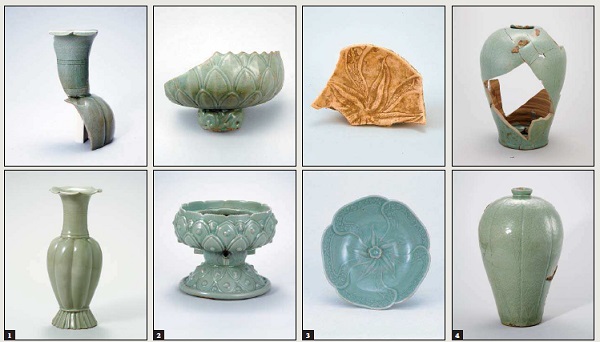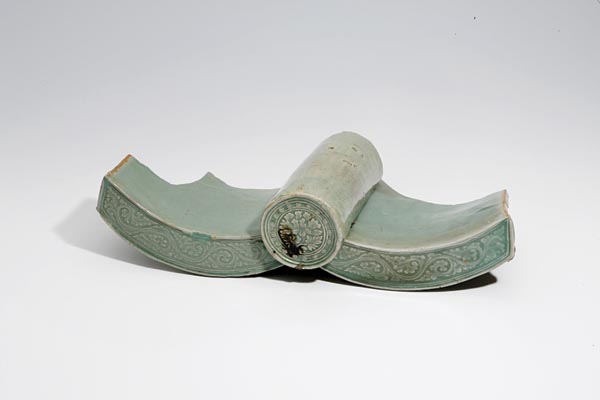Looking inside Goryeo-era celadon

Fragments from the Sadang-ri kiln site (top row) are displayed along with complete pieces of similar shape (bottom row) at an ongoing exhibit at the National Museum of Korea in central Seoul. From left: 1. The melon-shaped celadon bottle, National Treasure No. 94. 2. A lotus-patterned incense burner. 3. A hibiscus-inspired celadon cup. 4. A pear-shaped prunus vase. [NATIONAL MUSEUM OF KOREA]
Even the most skillful artisans have said it’s difficult to produce celadon pieces today that are as good as the old ones.
The current exhibition at the National Museum of Korea in Yongsan District, central Seoul, may be just the first step to solving that mystery.
The exhibition, titled “Goryeo Celadon of Sadang-ri Kiln Site in Gangjin,” is displaying Goryeo-era celadon fragments discovered at the site of the Sadang-ri kiln in Gangjin County, South Jeolla, during the archaeological excavation that the museum conducted there from 1964 and 1997.
The Sadang-ri kiln was where artisans made celadon pieces that were to be used at the Goryeo royal court. During the excavation, researchers from the National Museum uncovered more than 100,000 celadon shards, as well as white porcelain and black-glazed vessels.
These have been kept at the museum’s archive until now.
“The fragments are actually more useful for us to find out the full story of Goryeo-era celadon art, compared to complete pieces,” Jang Seong-wook, a researcher at the museum’s fine arts division, said.
For the exhibition, officials of the National Museum of Korea selected about 200 of the fragments found at the site as well as relevant celadon masterpieces from the era. The juxtaposition of the two types of artifact is meant to expand people’s understanding of the genre.
For instance, the melon-shaped celadon bottle, National Treasure No. 94, is one of the highlights of the National Museum’s collection of Goryeo celadon pieces. It was unearthed from the tomb of King Injong (1109-46).
But at the site of the Sadang-ri kiln, fragments that look strikingly similar to the famous bottle have been found. They are displayed side-by-side to highlight the correlations among the pieces.
Other highlights of the exhibition are the celadon roof tiles. There are historical records from 1157 that say the Goryeo Dynasty built a pavilion called Yangijeong with celadon roof tiles.

Celadon roof tiles are among the highlights at the “Goryeo Celadon of Sadang-ri Kiln Site in Gangjin” exhibition. Shown here is a 12th-century roof tile found at the Sadang-ri kiln site in Gangjin County, South Jeolla. [NATIONAL MUSEUM OF KOREA]
Another interesting aspect of the exhibition, officials say, is how it displays white porcelain and black-glazed vessels. Officials say these show how the Goryeo artisans attempted to be more creative. It’s these attempts that led to the advent of buncheong sagi, or buncheong ware.
Buncheong ware, greyish-blue ceramic covered in coarse white glaze, was produced during the first 200 years of the Joseon Dynasty (1392-1910) and embodies the transition from Goryeo celadon to Joseon porcelain.
“The Sadang-ri kiln symbolizes the heyday of Goryeo celadon art that was possible thanks to the highest technology of that time and the aesthetics and sentiment unique to the Goryeo people,” Jang said. “We hope people can feel like they’ve seen the fresh celadon pieces just taken out from the kilns.”
BY KIM HYUNG-EUN
[hkim@joongang.co.kr]
The “Goryeo Celadon of Sadang-ri Kiln Site in Gangjin” exhibition runs until Feb. 21. Admission is free. Opening hours of the museum are 9 a.m. to 6 p.m. on weekdays. The hours are extended until 9 p.m. on Wednesdays and Saturdays to encourage nighttime visits. Opening hours on Sundays and holidays are 9 a.m. to 7 p.m. The venue is close to Ichon Station (lines No. 1 and 4), exit 2. For more information, call (02) 2077-9000 or visit www. museum.go.kr.










with the Korea JoongAng Daily
To write comments, please log in to one of the accounts.
Standards Board Policy (0/250자)